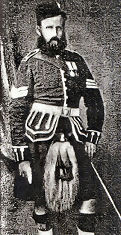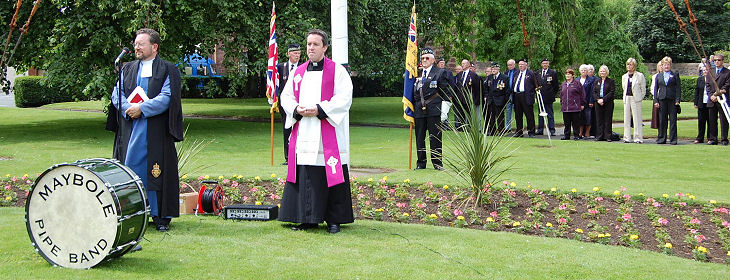 |
A
plaque on the town’s main flagpole
commemorating
William James Montgomery Cuninghame VC
(left) and
Samuel McGaw VC (right) was unveiled by
John McWhirter and Mary Davidson,
descendants of Sgt McGaw. Branch secretary
George Taylor laid a wreath at the foot of
the flagpole which is a war
memorial to the dead in two World Wars.
Maybole Pipe Band had led a parade from
Crosne Street followed by branch standard
bearers William Milligan and Robert Malone,
members of the branch and the Women’s
Section, Depute Lord Lieutenant Col George
Hay, Provost Winifred Sloan, Cathy Jamieson
MSP, South Ayrshire Councillors Brian
Connolly, Ann Galbraith, Sandra Goldie,
Mairi Low and Alex Oattes, Inspector Stuart
Gaudin, members of Maybole Community
Council, visitors from other branches and
patients from Hollybush House. |
 |
The parade marched via Culzean Road to
the Greenside where the pipe band drummers stacked their
drums before the standards were draped over them.
Rev Dave Whiteman told
those gathered that William James Montgomery Cuninghame
VC was presented with his medal on 26th June 1857 in
Hyde Park, London, when Her Majesty Queen Victoria held
the very first investiture of the award.
Legion members had
thought that it would be appropriate to mark the 150th
anniversary of this with a special service and at the
same time honour Samuel McGaw who was awarded his
Victoria Cross on 18th April 1874 also by Queen
Victoria.
After
the plaque was unveiled the standards and drums were
collected and the parade marched via Ladyland Road and
Whitehall for the salute taken by Col Hay at the Town
Hall..
 |
 |
|
Presentation of two 50p pieces which carry a
special souvenir of the 150th anniversary of
the first VC awards |
Reading at
Maybole Green |
Rev Whiteman also
explained during the ceremony how the two men had earned
the country’s highest award and he recounted their
connection to Carrick.
William James
Montgomery Cuninghame was born on 20th May 1834 in the
parish of Maybole, the son of Sir Thomas Montgomery
Cunninghhame and Charlotte Niven D Hutcheson.
Just prior to his 20th
birthday he enlisted on 11th March 1853 as a Lieutenant
in the 1st Battalion The Rifle Brigade (Prince Consort's
Own).
On 20th November 1854,
while serving with his regiment during the Crimean War,
he was ordered to attack several Russian rifle pits on
rising ground which were really caves dug into the side
of the hill.
The capture of the
rifle pits was essential to the advance of the British
troops and during the night and for some time the
following morning the Russians made repeated attempts to
recapture the rifle pits.
The British party under
the leadership of Lieutenant (Brevet Captain) Cuninghame
and Lieutenant (Brevet Major) Bourchier held out against
superior numbers until they were relieved by another
party from their own regiment.
For their actions
during the initial attack and the subsequent defence of
the rifle pits against superior forces, Lieutenant
Bourchier and Cuninghame were awarded the VC.
Lieutenant Cuninghame VC eventually attained the rank of
Colonel and in 1874 he retired from the army. He
continued to reside with his family at Glenmoor House
which he later renamed Kirkbride House. He served as MP
for Ayr from 1874 to 1880 and died on 11th November
1897. He was buried in the family plot in Kirkmichael
Churchyard on 17th November 1897.
Samuel McGaw was
awarded his Victoria Cross for action at the Battle of
Amoaful. On 18th April 1874 he was presented with his
award by Her Majesty Queen Victoria at Osborne Castle,
Isle of Wight.
He was born in 1837 in
Kirkmichael, the eldest son of William McGaw and his
wife Sarah Thomson. Aged 20, on 15th August 1857 Samuel
enlisted in the 42nd Royal Highlanders. On 12th
September 1861 the name "Black Watch" was added to the
Regiment's title.
The King of Ashanti
(Ghana) sent his troops in 1873 to attack the friendly
tribes of the British Protectorate of the Gold Coast
where very few British troops were stationed. Urgent
reinforcements were required and amongst these were the
42nd Highlanders. The Black Watch sailed from Portsmouth
on 3rd December 1873, arriving in the Gold Coast ten
days before Christmas.
Soon
after the New Year they set off for Coomassie (Kumasi)
the capital of Ashanti 150 miles inland. During their
advance the main action of the campaign was at the
Ashanti town of Amoaful where Lance Sergeant McGaw
although severely wounded early in the initial attack
led his section through the dense thorny bush and
engaged the enemy several times during the day. For his
conduct throughout the battle Samuel McGaw was later
awarded the Victoria Cross, one of four awarded during
the Ashanti Campaign.
Samuel
was posted overseas to Malta on 14th November 1874. From
Malta the Regiment moved to Cyprus where they
disembarked at Larnaca on 22nd July 1878, and set off
for Camp Chiflik Pasha that same day. Whilst on the
march to the camp Sergeant McGaw died of heat stroke. He
was buried close to where he had died and a wooden
marker was set up to mark the spot.
Some three years later,
the Commissioner of Kyrenia, Colonel Scott Stevenson
formerly of the Black Watch, learned that the Greek
farmer who owned the land on which Sergeant McGaw was
buried , had removed the wooden grave marker and had
ploughed the land over the grave. Colonel Stevenson
traced the site of the grave, exhumed the remains and
placed them in a coffin which was taken to Kyrenia
where, covered with a Union Flag and carried by six
Turkish Zaptiehs, it was reburied in the English
Cemetery. After the funeral Mrs Scott Stevenson
decorated the grave with wreaths of passion flowers and
jasmine. The grave was then marked with an ancient
sarcophagus and is alongside the graves of other members
of the Regiment who died in the campaign. |
